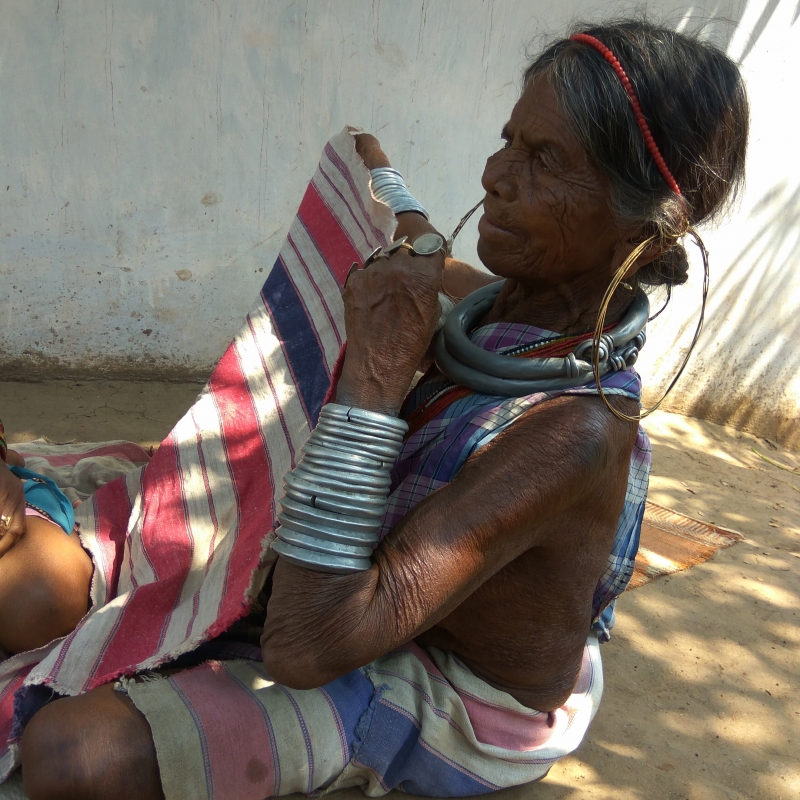I am a headmaster at Machkund State Government School in Lamptaput block of Koraput district of Odisha and teach students till seventh standard. I grew up in a small village near Machkund and studied in the local school.
The Gadaba community has been categorised as Scheduled Tribe, among the sixty two tribes of Odisha. Our historical roots suggest that Gadaba Adivasi lived near a place called ’Gada’ near the Godavari river and our ancestors migrated to Similigida, Lamptaput, Baipariguda, Nandpur and Jeypore in Koraput district of Odisha before the reign of Nandpur Raja. Gadaba settled in small hamlets in the deep forest according to their clan and subgroups.
The indigenous culture of Gabada is closely connected with prakruti—the natural environment. Since generations our ancestors were always self-dependent from cultivating their own food to preparing their own fabrics. According to our legends, the first paddy was discovered and cultivated by Gadaba adivasi not just in India but also in the entire world, which we are proud about. Gadaba were always dependent on nature for food, shelter and clothing thus Bana Debta, the nature god, is the supreme god for our community.
Preparing our own cloth is a significant part of Gadaba culture. In earlier days, after reaching puberty a girl must know how to weave and she should be able to weave two pieces of kerang as a criterion for marriage. Gadaba women collected plants from the forest and prepared fibre by spinning it into threads and then into a piece of cloth to cover the body in two pieces of kerang. The process was lengthy and women worked hard to make one kerang.
The times have changed and varieties of textiles are available easily in the local market. Women have almost stopped weaving as it is easier to buy cloth from the market instead of making it from fibre to fabric. Nobody wants to work hard when access to material has become so easy in comparison to earlier days. kerang is also associated with our pride but the tradition of bark cloth, kerang, has almost finished and it will die very soon.
Gadabas’ social life and rituals are as per the niyam (natural law) of the nature god. In our culture nature god is everything. Idol worship is not part of Gadaba culture. With the influence of the mainstream world local people have started worshiping idols. Gabadas worship surya (sun god), jal (god of water) and the trees (god of trees). Before enunciating every word Gadaba thinks of Basmati, the earth goddess who lives below, and the Daramdevta (the sky god) who lives above.
On every auspicious occasion and before every small activity Gadaba recall all the local nature gods such as Daramdevta and Basmati. We do not call Krishna or any other god. Gadabas are adivasi—we worship nature. We are neither Hindu nor should be categorised under any other religion. Our practices and belief are closely related with nature and we follow the niyam of nature. During rituals Gadaba think of Patal kamini (goddess of the sky), Jal kamini (goddess of the river) and Dongor devi (goddess of the jungle) with reverence and love.
A sacrificial ritual is a must as the nature god demands it. The sacrifice of a goat or fowl during small rituals is the way Gadaba show their respect to nature god. This is how we satisfy nature god’s demands. Gadaba cannot think of annoying the local gods. Local people fear death, disease and misfortune if nature god is unhappy. Sacrifices are made as part of the niyam, it is part of our culture and we must be proud of our culture.
During Chaita Purba, Dialli Mas and Barbati, local people celebrate and venerate local deities such as Bhairava. Many years ago buffalo sacrifice (podo) was also practised by Gadabas like it is in the Dongria Kondh community. In our villages the local deities are important; the other communities who live with us also believe in them and participate in our rituals. During Dingri Purbo people pray to the birds to protect their crops.
With the influence of the mainstream world, the Gadaba have started disassociating with indigenous practices. Sacrificial ritual was abolished by the government. People who consumed buffalo meat have stopped eating it. Now, Gadabas are trying to become like others. We are losing many traditions in the fast moving world. Our own local language Gutob is under threat. The younger generation has stopped speaking Gutob. Desia is widely spoken and school education also insists on Odia language.
As a Gadaba, I understand the complexities of language. Students who speak Gutob and Desia struggle to cope with Odia. If they do not pass the exam, the students lose hope and often discontinue their education. In the name of development we have lost the forest, we are disconnecting from the local traditions, our language is disappearing and kerang, the proud bark cloth of our community is not woven anymore.
Cultural Narration about the Gadaba adivasi












